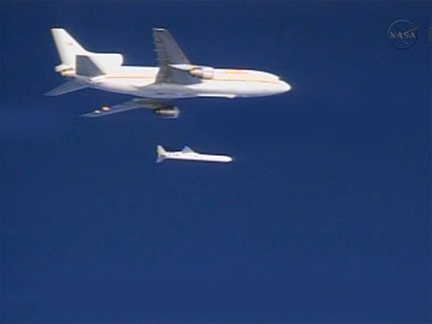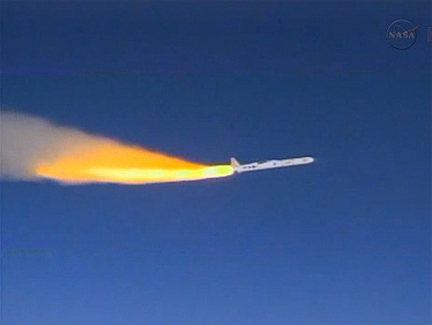Pegasus rocket carries sun-study satellite into orbit
06/27/2013 11:12 PM Filed in: Space News | Space Science
By WILLIAM HARWOOD
CBS News
A winged Pegasus rocket lifted a compact solar observatory into orbit around Earth's poles Thursday, kicking off a $181 million mission to shed light on a major mystery: what heats up the sun's outer atmosphere to extreme temperatures and how that, in turn, affects Earth's space weather.
NASA's Interface Region Imaging Spectrograph, or IRIS, spacecraft will focus on the dynamic zone between the sun's 6,000-degree visible surface -- the photosphere -- and the tenuous corona, which is somehow heated to more than a million degrees over a span of a few thousand miles.
Scientists hope to gain insights into the energy transport mechanisms that drive the solar wind -- the supersonic stream of atomic particles blasted away from the sun -- solar flares and explosive eruptions known as coronal mass ejections that occasionally disrupt power grids, satellite operations and communications on Earth.
"What we want to discover is what the basic physical processes are that transfer energy and material from the surface of the sun to the outer atmosphere of the sun, the corona," Alan Title, IRIS principal investigator at Lockheed Martin's Advanced Technology Center, told reporters before launch.
"The visible surface (is) the place where virtually all of the light that leaves the sun leaves from. Immediately above that, the temperature rises to the million-degree corona. How that happens is a mystery. What are the processes that occur there?"
Making the program's 42nd flight, the Orbital Sciences Pegasus XL rocket was carried aloft from Vandenberg Air Force Base, Calif., by an L-1011 carrier jet.
The Orbital Sciences "Stargazer" jet carried the 51,000-pound rocket to a pre-determined drop point over the Pacific Ocean and, after final tests were completed, released the Pegasus at a planned altitude of 39,000 feet at 10:27 p.m. EDT (GMT-4; 7:27 p.m. local time).
A few seconds later, 300 feet below the carrier jet and gliding southward at about slightly more than 80 percent the speed of sound, the Pegasus XL's first stage solid-fuel motor ignited with a rush of exhaust and the spacecraft quickly shot away toward space.
All three stages of the Pegasus XL rocket appeared to operate normally and about 13 minutes after launch, telemetry indicated the 403-pound IRIS spacecraft had been released into an orbit tilted 98 degrees to the equator with a high point of about 420 miles and a low point of some 385 miles.
"We're thrilled. We're very excited," said Launch Director Tim Dunn. "The spacecraft, we've made initial contact with it (through a NASA communications satellite). We've gotten good data back. The solar arrays did begin to deploy and everything is proceeding right on track."
It will take engineers about two months to check out the spacecraft's systems, calibrate its instruments and begin routine science observations. The trajectory was designed to ensure about eight months of uninterrupted observations each year.
The solar powered IRIS spacecraft is equipped with an 8-inch telescope and a multi-channel imaging spectrograph that will study ultraviolet emissions from the corona and the interface between it and the sun's visible-light surface.
Title said IRIS has "about a factor of 10 higher resolution than any other instrument that has explored this region and, even more importantly, it's about a factor of 20 faster. So it can take images about once a second. This is critical because the processes that occur in this part of the atmosphere happen very, very fast."
"Previous observations suggest there are structures in this region of the solar atmosphere 100 to 150 miles wide, but 100,000 miles long," he said. "Imagine giant jets like huge fountains that have a footprint the size of Los Angeles and are long enough and fast enough to circle Earth in 20 seconds. IRIS will provide our first high-resolution views of these structures along with information about their velocity, temperature and density."
IRIS data will complement observations by the much larger, and more expensive, Solar Dynamics Observatory spacecraft.
"IRIS almost acts as a microscope to SDO's telescope," Hall said in a NASA overview. "It's going to look in closely and it's going to look at that specific region to see how the changes in matter and energy occur in this region. It's going to collectively bring us a more complete view of the sun."
CBS News
A winged Pegasus rocket lifted a compact solar observatory into orbit around Earth's poles Thursday, kicking off a $181 million mission to shed light on a major mystery: what heats up the sun's outer atmosphere to extreme temperatures and how that, in turn, affects Earth's space weather.
NASA's Interface Region Imaging Spectrograph, or IRIS, spacecraft will focus on the dynamic zone between the sun's 6,000-degree visible surface -- the photosphere -- and the tenuous corona, which is somehow heated to more than a million degrees over a span of a few thousand miles.
 |
| An Orbital Sciences Pegasus XL rocket carrying a new sun-study satellite falls away from the company's carrier jet moments before first stage ignition. (Credit: NASA TV) |
"What we want to discover is what the basic physical processes are that transfer energy and material from the surface of the sun to the outer atmosphere of the sun, the corona," Alan Title, IRIS principal investigator at Lockheed Martin's Advanced Technology Center, told reporters before launch.
"The visible surface (is) the place where virtually all of the light that leaves the sun leaves from. Immediately above that, the temperature rises to the million-degree corona. How that happens is a mystery. What are the processes that occur there?"
Making the program's 42nd flight, the Orbital Sciences Pegasus XL rocket was carried aloft from Vandenberg Air Force Base, Calif., by an L-1011 carrier jet.
The Orbital Sciences "Stargazer" jet carried the 51,000-pound rocket to a pre-determined drop point over the Pacific Ocean and, after final tests were completed, released the Pegasus at a planned altitude of 39,000 feet at 10:27 p.m. EDT (GMT-4; 7:27 p.m. local time).
A few seconds later, 300 feet below the carrier jet and gliding southward at about slightly more than 80 percent the speed of sound, the Pegasus XL's first stage solid-fuel motor ignited with a rush of exhaust and the spacecraft quickly shot away toward space.
 |
| The solid-fuel first-stage motor of the Pegasus XL rocket roars to life above the Pacific Ocean, pushing the Interface Region Imaging Spectrograph, or IRIS, spacecraft toward orbit. (Credit: NASA TV) |
"We're thrilled. We're very excited," said Launch Director Tim Dunn. "The spacecraft, we've made initial contact with it (through a NASA communications satellite). We've gotten good data back. The solar arrays did begin to deploy and everything is proceeding right on track."
It will take engineers about two months to check out the spacecraft's systems, calibrate its instruments and begin routine science observations. The trajectory was designed to ensure about eight months of uninterrupted observations each year.
The solar powered IRIS spacecraft is equipped with an 8-inch telescope and a multi-channel imaging spectrograph that will study ultraviolet emissions from the corona and the interface between it and the sun's visible-light surface.
Title said IRIS has "about a factor of 10 higher resolution than any other instrument that has explored this region and, even more importantly, it's about a factor of 20 faster. So it can take images about once a second. This is critical because the processes that occur in this part of the atmosphere happen very, very fast."
"Previous observations suggest there are structures in this region of the solar atmosphere 100 to 150 miles wide, but 100,000 miles long," he said. "Imagine giant jets like huge fountains that have a footprint the size of Los Angeles and are long enough and fast enough to circle Earth in 20 seconds. IRIS will provide our first high-resolution views of these structures along with information about their velocity, temperature and density."
IRIS data will complement observations by the much larger, and more expensive, Solar Dynamics Observatory spacecraft.
"IRIS almost acts as a microscope to SDO's telescope," Hall said in a NASA overview. "It's going to look in closely and it's going to look at that specific region to see how the changes in matter and energy occur in this region. It's going to collectively bring us a more complete view of the sun."